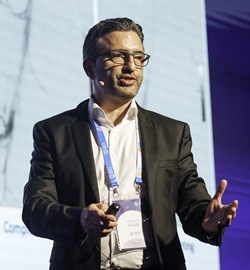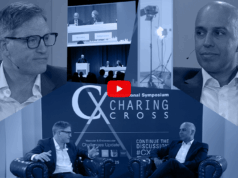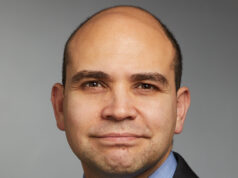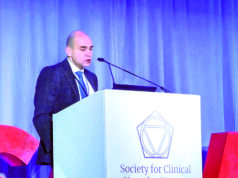This advertorial, sponsored by BD, is intended only for readers outside the USA.

“A dedicated, holistic venous approach is mandatory—including deep, superficial and pelvic venous systems,” says Houman Jalaie (University Hospital RWTH Aachen, Aachen, Germany), outlining what he believes was the key message emanating from a thoroughly successful BD Venous Summit (19–21 June 2023, Riga, Latvia).
The summit—for which Jalaie was co-director alongside Lowell Kabnick (Morristown Medical Center, Morristown, USA)—saw venous experts gather from far and wide to discuss a range of topics; perhaps most notably, the criticality of adopting multidisciplinary approaches, and engaging all relevant centres and specialties, to ultimately improve patient outcomes.
“There is a need for a couple of high-volume venous centres in each bigger country,” Jalaie continues, digging deeper into how these multidisciplinary, collaborative strategies can be implemented in a ‘real-world’ sense. “In order to offer the best possible diagnosis, indication and treatment, there is a clear need for running a multidisciplinary approach well.
“This does not mean that all departments should perform the interventions. For example, if one discipline has decided to go for dedicated venous care—taking the lead of the venous centre—there should be a cooperation with other medical departments for the best possible diagnostics, the best possible labour and also the best possible postoperative support. This also means the best anticoagulation approach.
“In order to achieve this aim, other specialities should be included regularly in decision making; of course, under the [guidance] of the main leading discipline. They should also be invited to venous congresses even if they are not directly treating these patients. A cooperation in research and science would be very helpful in order to create a team feeling as well.”
Providing her take-home messages from the summit, Wassila Taha (Alfa Scan Imaging Center, Cairo, Egypt)—another of the venous experts in attendance—states that, “depending on the specific venous condition, various treatment options should be offered to our patients”.
“These may include medications, minimally invasive procedures like sclerotherapy or endovenous ablation, or surgical interventions in more severe cases,” she adds. “The appropriate treatment will depend on the individual patient and the severity of the condition—and a well-detailed diagnostic workup with ultrasound and cross imaging.”
Making venous care holistic
Many of these messages were reflected throughout the Venous Summit—for example, in a presentation from Domenico Baccellieri (Vita-Salute San Raffaele University, Milan, Italy), who discussed his experiences of building a successful, dedicated venous centre. In addition to echoing Jalaie’s sentiment that a multidisciplinary approach is “mandatory” in this process, Baccellieri highlighted in-hospital and extra-hospital promotional activities, as well as research programmes, as “key” tools.
He went on to note the importance of establishing physician referral networks and ‘human contact’ with general practitioners (GPs), informing the Venous Summit audience that these—along with patient engagement and education—these considerations pose a challenge to the formation of specialised venous care in Italy. Jalaie agreed with Baccellieri on this point, commenting that “the same problem” is present in Germany as well.

Discussions in Riga also saw Taha outline the successes of an initiative at her own hospital in which less specialised practices like wound dressing and compression therapy for venous leg ulcers were performed by ‘non-experts’, ultimately resulting in positive patient outcomes. Based on this, Taha asserted the importance of involving medical staff of all levels in venous care strategies.
Manjit Gohel (Addenbrooke’s Hospital, Cambridge, UK) later supported these key points raised by Taha, not only emphasising the vital role of compression therapy, stating that “we must not forget the basics”, but also of effective communication between primary and secondary centres so that patients can be transferred from everyday hospitals to specialised institutions. He concluded that “we have to form partnerships”.
Elsewhere on the programme, Suat Doganci (Health Sciences University, Ankara, Turkey) corroborated many of his colleagues’ views, highlighting public awareness programmes as useful mechanisms for improving venous care—giving social media as an example of a place where these programmes and campaigns can be hosted, and shared more widely.
This led Jalaie and Efthymios Avgerinos (Athens Medical Group, Athens, Greece) to agree on the utility of social media for spreading awareness and transmitting patient education, although Avgerinos also noted this is likely best done “in moderation” while Jalaie advised caution, owing to the fact that “misinformation can spread quickly”.
Future directions
Reflecting on the three-day summit, Taha highlights the need to calculate a ‘good’ inflow; prior iliac venous reconstruction; and assuming a good inflow threshold flow volume to maintain long-term venous stent patency, as important considerations in venous care. And, speculating on the future needs of the specialty, she notes that a trial involving genetic therapy as a means for mitigating the progression of venous disease is also to offer promise.
“Increasing patient compliance of wearing compression garments, and improving the manufacturing of these garments to adapt to countries with hot weather,” Taha avers, returning to the topic of compression therapy, and the unmet needs that must be tackled in this space.
Once again homing in on the concept of multidisciplinary venous care—and providing a brief glimpse of the direction the specialty should take moving forward—Jalaie states that, following an “extensive basic vascular education” as a vascular and endovascular surgeon, interventional radiologist or angiologist, “one should make a deep dive into the venous field and go for a holistic, dedicated approach to care”.
“This includes diagnostics, indication-making, treatment, postoperative evaluation and support,” he adds. “And, all this should be supported by an interdisciplinary team—haematology, gynaecology, internal medicine and radiology. These big venous centres should also focus on clinical and basic research in order to achieve more evidence.; with more evidence, better governmental support with [improved] reimbursement will be achieved, which will further boost the rising field of vascular medicine.”











